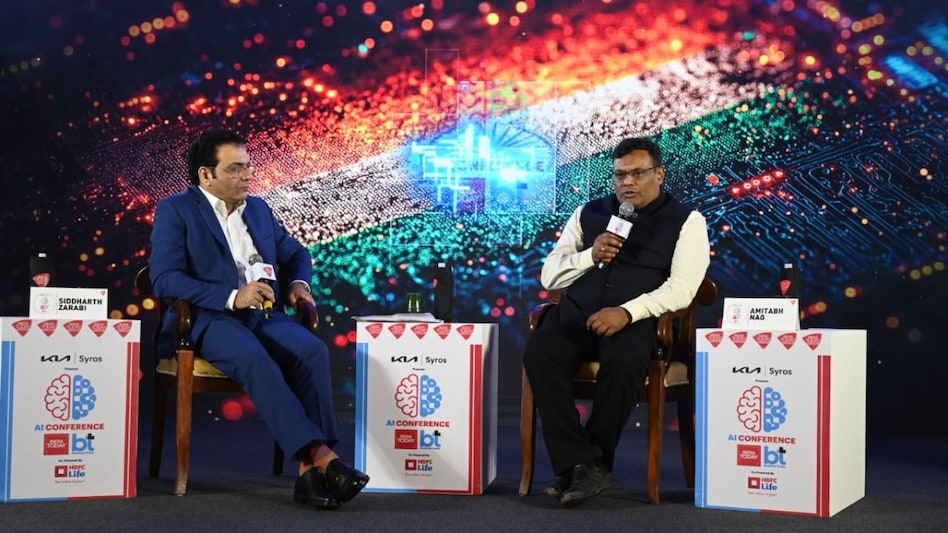 During his conversation with Siddharth Zarabi, Editor of Business Today, at the Business Today-India Today AI Conclave 2024, Nag discussed the transformative impact of Bhashini.
During his conversation with Siddharth Zarabi, Editor of Business Today, at the Business Today-India Today AI Conclave 2024, Nag discussed the transformative impact of Bhashini.  During his conversation with Siddharth Zarabi, Editor of Business Today, at the Business Today-India Today AI Conclave 2024, Nag discussed the transformative impact of Bhashini.
During his conversation with Siddharth Zarabi, Editor of Business Today, at the Business Today-India Today AI Conclave 2024, Nag discussed the transformative impact of Bhashini. Amitabh Nag, CEO of BHASHINI at MeitY, shared that the homegrown AI platform processes around 6 million inferences daily, making it one of the largest systems globally. He also highlighted how Bhashini has created digital data for languages like Sindhi, which previously lacked a digital presence.
During his conversation with Siddharth Zarabi, Editor of Business Today, at the Business Today-India Today AI Conclave 2024, Nag discussed the transformative impact of Bhashini.
“We face five core challenges,” he explained. “First, digital systems must be able to understand speech in 22 languages. Second, computers must be able to translate text from one language to another in these 22 languages. Third, a system must convert text into speech. Fourth, we need to interpret printed texts, which are scanned as pixels or images, and convert them into editable text. Lastly, there is a need to build a digital vocabulary for the country — many names and terms are present in physical dictionaries but are missing in digital forms. This is a significant area we are working on,” he said.
“These five core issues are: automatic speech recognition, text-to-text translation, text-to-speech conversion, optical character recognition, and named entity recognition. We are tackling all these in 22 languages,” he added.
Nag emphasised the crucial role of AI in addressing these challenges, noting that Bhashini has developed over 300 AI models, which are open-sourced and available as a service through its platform.
Regarding the development of a homegrown database, Nag highlighted that only six or seven languages had significant digital data available, so Bhashini embarked on an innovative approach to gather data. “We took pictures using a mobile app and worked with people to speak about topics like monuments or food. We then transcribed these recordings. Over 200 people were involved in this task,” he explained.
Discussing the scale of the platform, Nag revealed that Bhashini processes about six million inferences daily. “This means content is processed six million times a day. We operate a system with approximately 150 GPUs, scaling up to 300-500 depending on the load and concurrency,” he said. He added that around 300 customers use these services across various sectors.
When asked about the suitability of small, medium, or large language models for India, Nag emphasized that the use case determines the model choice. He elaborated on the four divides that India faces: financial, digital, electricity, and language. He believes that Bhashini can help bridge these divides by enhancing solutions tailored to each issue.
Nag also shared a notable example of Bhashini’s impact: converting railway manuals into audio formats for visually impaired individuals. Additionally, he mentioned an ongoing project to make Indian maps available in 22 languages.
Regarding language models, Nag explained, “The use case determines whether small or large models are required.”
When asked if India could lead globally in AI, Nag expressed confidence in India's ability to harness technology at scale. He pointed to successful initiatives like UPI, passport issuance, e-filing, income tax filing, and vaccine distribution during the COVID-19 pandemic as evidence of India’s leadership in leveraging technology for governance and public services.
Looking ahead, Nag envisions a future where language will no longer be a barrier for Bhashini users. “In the future, no matter what language you speak, the system will seamlessly translate it,” he concluded.
For Unparalleled coverage of India's Businesses and Economy – Subscribe to Business Today Magazine
Copyright©2025 Living Media India Limited. For reprint rights: Syndications Today